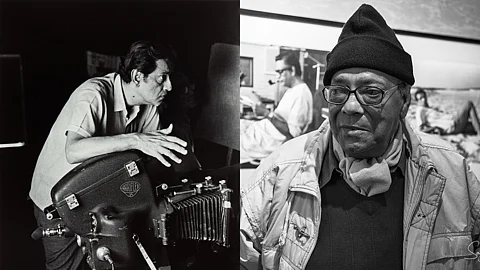
- HOMEGROWN WORLD
- #HGCREATORS
- #HGEXPLORE
- #HGVOICES
- #HGSHOP
- CAREERS
- ABOUT US
- CONTACT US

Satyajit Ray once described Nemai Ghosh as 'Boswell with a camera' as an acknowledgment of the unparalleled devotion with which Ghosh chronicled Ray's life and work. Just as James Boswell's biography of English writer, lexicographer, and literary critic Samuel Johnson is hailed as one of the finest ever written, Ghosh's visual documentation of Ray's life and work over more than two decades represents some of the most intimate and enduring photographic portraits of the celebrated filmmaker. From 1968 until Ray's death in 1992, Ghosh served as his official 'Unit Stills Photographer' and unofficial biographer, capturing over 90,000 images — both on film sets and at home — with a sensitivity that reflected their extraordinary partnership. Surprisingly, his path to photography was anything but conventional.
Before he ever picked up a camera, Ghosh was a theatre actor, associated with screen and stage legend Utpal Dutt's influential Little Theatre Group in Kolkata. He even played the lead in the 1959 production of Angar. His transition to photography came by chance: a friend, unable to repay a loan of Rs 240, offered him a Canonette QL-16 fixed-lens camera found in a taxi. Ghosh accepted the camera in place of the debt — and unknowingly stepped into his life's calling.
"Ray's dedication to his craft led Ghosh to follow him like a shadow and conditioned him to the exacting demands of the maestro. Over the course of a twenty-five- year association that began on the sets of 'Goopy Gyne Bagha Byne', Ghosh remained steadfast in upholding the values that defined Ray's artistic vision. In Ray, Ghosh found not just a filmmaker but a mentor and friend; no other director's set quite measured up. With Ray's encouragement, what began as a passion evolved into a profession, and Ghosh was eventually credited as ‘Unit Stills Photographer’."
Ashish Anand, CEO and MD, DAG
Introduced to Ray by the acclaimed art director Bansi Chandragupta at the set of Goopy Gyne Bagha Byne, Ghosh showed the filmmaker a few of his early photographs. Impressed by the young man's instinctive eye, Ray invited him to join his production team in 1968 — a moment that marked the beginning of their life-long collaboration.
From 1968 until Ray's death in 1992, Ghosh was a constant, often invisible presence behind the scenes of Ray's films — quietly documenting the work and world of one of India’s greatest auteurs. Over the years, Ghosh produced an extraordinary body of work around Ray, capturing not just the making of films but also the spirit of an artist at work. His photographic books include Satyajit Ray at 70 (1991), with a foreword by Henri Cartier-Bresson; Satyajit Ray: A Vision of Cinema (2005), co-authored with Andrew Robinson; Manik-Da: Memories of Satyajit Ray (2011); Satyajit Ray and Beyond (2013); and Faces and Facets: Ray in Colour (2020), the latter two published by DAG. These volumes offer rare glimpses into Ray's creative process, and together they form a remarkable visual archive of Indian cinema's golden era. In recognition of his contributions, Ghosh was awarded the Padma Shri by the Government of India in 2010. He passed away at his home in Kolkata on 25 March 2020.
'Light and Shadow: Satyajit Ray through Nemai Ghosh’s Lens', presented by DAG in collaboration with Kolkata's Alipore Museum, is a landmark exhibition of Nemai Ghosh's photographic oeuvre. Featuring both iconic black-and-white photographs of Satyajit Ray at work and in his home, as well as never-before-displayed color photographs of actors, scenes, sets, and locations during the filming of Ray's films, taken over a twenty-five-year period, the exhibition showcases the unparalleled genius and magic of Satyajit Ray through Nemai Ghosh's lens.
Light and Shadow: Satyajit Ray through Nemai Ghosh’s Lens, presented by DAG, is on display at the Alipore Museum, Kolkata, until 13 September 2025. Follow DAG for more information.
